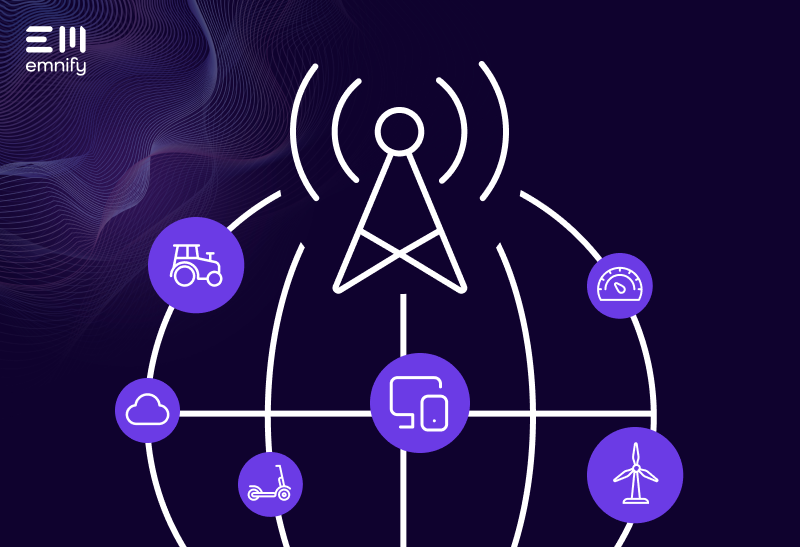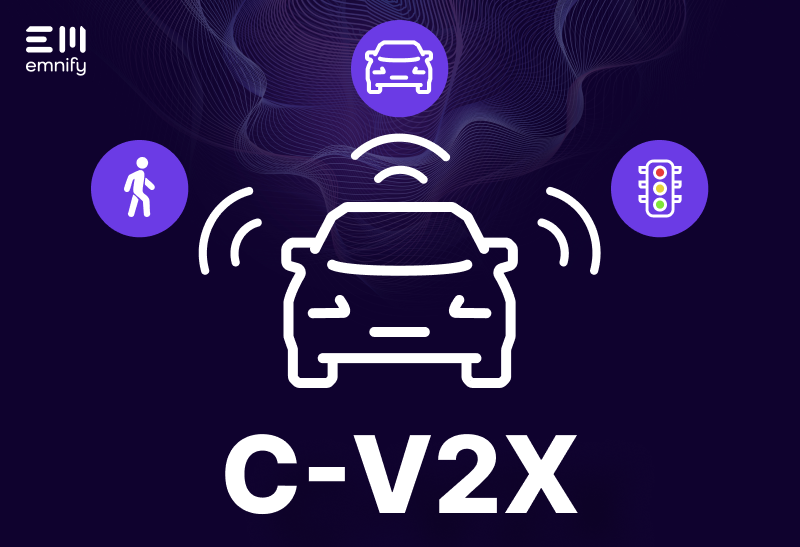

Health-related data informs personal and professional healthcare decisions and can even trigger emergency services. In many cases, receiving healthcare data in a timely manner is a matter of life and death.
With the help of IoT devices, e.g. neonatal infant care units can actively monitor premature babies’ temperatures, heart rates, breaths per minute, oxygen levels, and other vital information. All that, without disturbing their patients or physically checking each monitor.
Healthcare administrators can also use IoT asset-tracking devices to ensure nurses and other professionals can quickly find the medical equipment they need.
Nursing homes and long-term care facilities may use IoT bracelets, necklaces, and other wearables for fall detection, so caretakers can respond faster and residents can get help regardless of the time of day or their location.
Healthcare IoT goes beyond hospitals and healthcare facilities as well. Consumers use wearable IoT devices to monitor their heart rate, physical activity, and glucose levels throughout the day. Pools may use IoT devices for things like drowning detection, using sensors to monitor when someone has been underwater for too long and alert staff if someone may be in danger.
For IoT manufacturers, the healthcare industry is ripe with opportunities for further digitization and optimization. But the stakes are also incredibly high, and many of the typical IoT security and IoT connectivity challenges become more critical when dealing with personal health data and life-or-death situations.
In this guide, we’ll look at the key factors you need to consider when developing healthcare-related IoT applications, and the five most common connectivity solutions for IoMT devices.
Key factors for IoMT connectivity
Over the years, manufacturers have used a wide range of connectivity solutions for the Internet of Things (IoT). Some of these solutions were purpose-built for IoT, and others were designed for other purposes, but work fine (or as a last resort) for IoT. The most important thing to consider when comparing solutions is where and how your device will be used. For IoT in healthcare (read: Internet of Medical Things, IoMT), the following factors tend to be most important:
Let’s look at each of these in more detail.
Mobility without losing connectivity
Not every IoMT application is mobile, but any wearable device or equipment that may be used in ambulances, medevac copters, and other mobile environments will need to maintain connectivity while in motion. Some network types are suitable for stationary settings like a hospital room, operating room, or administrative desk, but lose connection as soon as the user moves with the device.
Some mobile connectivity solutions, such as Bluetooth, require you to keep additional infrastructure near the device as it moves. (In the case of Bluetooth, this is as simple as keeping a wearable IoT device near a smartphone that it’s paired with.) And while there are a few types of networks that work in mobile applications, they all have a limit to how mobile your device can be. So it’s worth thinking about the extreme use cases you expect your device to be viable for and the maximum speed at which your preferred network can maintain connections.
Indoor penetration is a challenge
Hospitals are massive structures that often have thick concrete walls and numerous floors. Not all networks use signals that are strong enough to penetrate these materials. A network’s Maximum Coupling Loss (MCL) measures how much interference a signal can handle while still actually transmitting or receiving.
When comparing network types, you may not need to get that granular to make the right choice, but it will be important to understand the potential limitations your connectivity could have indoors. You wouldn’t want to deploy a device your customers could only operate on certain floors or in particular wings of a facility.
IoT Security
Healthcare providers are already on high alert when it comes to the security of their member and patient data. With regulations like HIPAA, they’re legally obligated to prevent unauthorized access to consumers’ health information. This information is also more desirable to hackers. Personal medical information can be as much as 50 times more valuable than credit card data.
Every year, healthcare providers find themselves fending off increasingly innovative cyber attacks. It’s vital that your IoMT devices can encrypt transmissions and support more robust IoT security measures, so that working with you doesn’t put your customers’ networks, data, and patients at risk.
Handling of bandwidth
The more devices you deploy in each location and the greater each device’s data consumption, the more bandwidth your network needs to support connectivity. If you don’t have enough bandwidth, your devices will interfere with each other and disrupt transmissions. It’s kind of like if everyone in an operating room reached for a scalpel at the same time: if there aren’t enough scalpels, somebody won’t have one when they need it.
The thing to keep in mind about bandwidth is that with some networks, your devices won’t only be competing for bandwidth with each other—they have to share it with other devices as well.
With WiFi, for example, your devices are competing with every computer, tablet, smartphone, smart TV, and other device on the network. And since every WiFi network uses the same two frequency bands, separate WiFi networks that are too close together can interfere with each other as well.
Maintaining coverage
Will your devices use your customers’ existing network, a local provider’s network, or a network you build on site? That all depends on the connectivity solution you choose. Some network types will require you to deploy new infrastructure for every customer. Others can connect to your customers’ networks (creating security risks and raising liability questions). And sometimes you can simply pay a large network operator for access to their network, which they’re responsible for keeping secure and available.
Connectivity solutions for healthcare IoT
While there are many different types of networks, in healthcare, there are five solutions that are far more common than the rest.
Let’s look at each of these in more detail.1. Cellular Connectivity
Cellular connectivity is the dominant choice for IoT, and it’s highly relevant for healthcare. It’s globally available, has substantial bandwidth, indoor penetration, and unparalleled mobility. You don’t have to think about your device’s range because Mobile Network Operators (MNOs) cover entire countries and use roaming partners to connect to networks in nearby countries.
With a high-quality IoT connectivity solution, your devices can connect to hundreds of cellular networks all around the world under a single plan, enabling you to deploy anywhere without creating new contracts.
While the first generations of cellular networks weren’t designed for IoT, a variety of new technologies have emerged specifically for the Internet of Things, including LTE-M, LTE Cat-M2, and NB-IoT. These specialized solutions offer the bandwidth most IoT applications need along with power-saving features to let your device “sleep” when not in use enabling battery powered devices.
Using cellular, you don’t have to rely on a customer’s network or build your own—you simply connect to a secure network that’s already available. Cellular components like IoT SIM cards help secure your connectivity, and partners like emnify enable you to implement additional security measures like VPN connections, network-level firewalls, IMEI locks, and connectivity profiles. Cellular has many advantages that make it an ideal choice for IoMT connectivity.
2. Bluetooth Pro & Con
For years, Bluetooth has been a common solution for mobile IoT devices. It’s incredibly simple to implement, and the most advanced Bluetooth technology has exceptionally low power consumption. In healthcare IoT, Bluetooth is often used for asset tracking, since it works well in mobile and indoor applications.
Rather than requiring you or a customer to build or maintain infrastructure, Bluetooth networks use a simple parent-child topology, where each device connects to a “parent.” In consumer IoT devices, this is usually the customer’s smartphone.
More advanced Bluetooth technology can also create “mesh” networks, where each connected device essentially expands the coverage of the network. Instead of a traditional “star” topology where everything connects to a central node, it’s like weaving a net, where every node can connect to all the other nodes within range and stay part of the network.
While Bluetooth does have longer range than most people assume, coverage is its weakness. Bluetooth devices on ambulances and other medevac vehicles will likely lose connectivity if they have to travel very far from the device it’s paired to, and if your device is used in emergency situations, that’s not a risk you want to take.
3. WiFi
WiFi is a popular choice for IoMT simply because it’s already widely available. Every healthcare facility has it and the vast majority of homes have it. If your healthcare device uses WiFi, odds are your customers will be able to get connected. But there are some major issues with using WiFi for IoT in general, and these issues become much larger concerns when your customers are healthcare providers.
With WiFi, every connected device represents an entry point to the network. If someone breached one of your IoT devices, it could potentially give them access to computers, servers, and other critical data sources on the network. Alternatively, if an employee left their computer unsecure or there was some other type of breach, any hacked device on the network could be used to access your IoT devices.
There are certainly options for securing WiFi networks and creating additional layers of security around your devices, but this begs the question: who is responsible for keeping your devices secure? You, or your customer? Even if you put that burden on your customers by using their WiFi network, when push comes to shove, they may still blame you in the event of a breach that involves your devices.
WiFi also consumes a lot of power. This isn’t a problem for devices that stay connected to a power supply, but for battery-powered devices, WiFi can dramatically lower their life expectancy. And of course, WiFi simply won’t work for mobile applications. Your customers can’t lug around WiFi infrastructure everywhere they go, and even limited motion can disrupt WiFi signals.
Other than its convenience, the main advantage of WiFi is that it offers high upload and download speeds, enabling your devices to quickly transmit and receive large data packages, including video files.
4. LoRaWAN
Long Range Wide Area Networks (LoRaWANs) are a type of Low Power Wide Area Network (LPWAN) built for IoT. LoRaWAN is a strong choice for deployments in remote areas where there is no network infrastructure in place, but it’s not a good solution for IoMT.
LoRaWAN uses unlicensed frequency bands, which means these networks are prone to interference, particularly in areas where there may be densely packed connected devices, such as a large city. It also has low bandwidth. Together, these characteristics can create significant connectivity issues.
5. Ethernet
Like WiFi, ethernet is a common choice simply because it’s widely available. Also like WiFi, ethernet raises questions about liability: who is responsible for building and maintaining the network? Who will your customers blame if your devices don’t work as needed? Who is at fault if there is a security breach?
Ethernet also takes WiFi’s mobility issues to another level: it’s far more difficult to relocate a device that’s connected via ethernet, let alone maintain a connection while moving the device. And since every ethernet-connected device needs its own ethernet cable, a given space is always going to have limited capacity for these devices.
But if your device doesn’t need to move, stays connected to a power supply, and requires significant bandwidth, ethernet can work--as long as there’s a place to connect.
This is how you connect your IoMT devices
There’s a reason cellular connectivity is so popular for the Internet of Things. It’s simple to use, boasts strong coverage (indoor, outdoor, and mobile), has high data throughput and excellent bandwidth, and encompasses a range of specialized solutions for different use cases.
emnify’s IoT communication platform takes full advantage of cellular connectivity and enables your devices to connect to more than 540 networks in over 180 countries. Our cloud native solution includes built-in redundancy to provide guaranteed network uptime of 99.99%, and you can integrate our connectivity data with all the tools you already use. Whatever your IoMT use case, emnify will keep your devices connected securely.
Get in touch with our IoT experts
Discover how emnify can help you grow your business and talk to one of our IoT consultants today!
More than six years of experience as a senior editor in the realm of smart home, connectivity and Internet of Things. And still as curious as on the first day.


